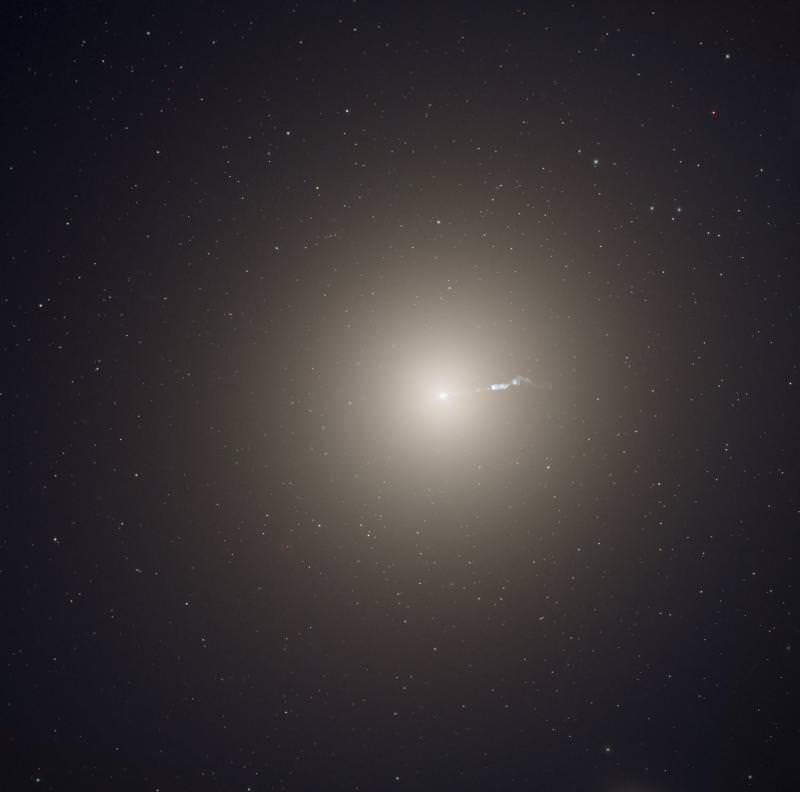[/caption]
Often in astronomy, one observable property traces another property which may be more difficult to observe directly; X-ray activity on stars can be used to trace turbulent heating of the photosphere. CO is used to trace cold H2. Sometimes these correlations make sense. Activities in stars produce the X-ray emissions. Other times, the tracer seems distantly related at best.
This is the case of a newly discovered correlation between the mass of the central black hole of galaxies and the number of globular clusters they contain. What can this relationship teach astronomers? Why does it hold for some types of galaxies better than others? And where does it come from in the first place.
The mass of a galaxy’s super massive black hole (SMBH) is known to have a strong relationship between many features of their host galaxies. It has identified to follow the range of velocities of stars in the galaxy, the mass and luminosity of the bulge of spiral galaxies, and the total amount of dark matter in galaxies. Because dark matter in the halo of galaxies and the luminosity have also been known to correspond to the number of globular clusters, Andreas Burkert of the Max-Planck-Institute for Extraterrestrial Physics in Germany, and Scott Tremaine at Princeton wondered if they could cut out the middlemen of dark matter and luminosity and still maintain a strong correlation between the central SMBH and the number of globular clusters.
Their initial investigation involved only 13 galaxies, but a follow-up study by Gretchen and William Harris and submitted to the Monthly Notices of the Royal Astronomical Society, increased the number of galaxies included in the survey to 33. The results of these studies indicated that for elliptical galaxies, the SMBH-GC relationship is evident. However, for lenticular galaxies there was no clear correlation. While there appeared to be a trend for classical spirals, the small number of data points (4) would not provide a strong statistical case independently, but did appear to follow the trend established by the elliptical galaxies.
Although the correlation appeared strong in most cases, about 10% of the galaxies included in the larger surveys were clear outliers. This included the Milky Way which has a SMBH mass that falls significantly short of the expectation from cluster number. One source of error the authors of the original study suspect is that it is possible that, in some cases, objects identified as globular clusters may have been misidentified and in actuality, be the cores of tidally stripped dwarf galaxies. Regardless, the relationship as it stands presently, seems to be quite strong and is even more tightly defined than that of the correlation between that of the SMBH mass and velocity dispersion that implied the potential relationship in the first place. The reason for the discordance in lenticular galaxies has not yet been explained and no reasons have yet been postulated.
But what of the cause of this unusual relation? Both sets of authors suggest the connection lies in the formation of the objects. While distinct in most respects, both are fed by major merger events; Black holes gain mass by accreting gas and globular clusters are often formed from the resulting shocks and interactions. Additionally, the majority of both types of objects formed at high redshifts.
Sources:
The Globular Cluster/Central Black Hole Connection in Galaxies


Intermediate sized black holes were found in globular clusters like M15, G1, and HLX-1. The black hole mass to star number ratio for globular clusters matches galactic SMBHs. Globular clusters are spherical shaped not flat, and mostly reside within the squashed beachball dark matter halo areas surrounding galaxies that is outside the flat disc spiral arm plane. Many GC’s author says could be “tidal stripped dwarf galactic cores” perhaps these intermediate sized black holes cause the dark matter galaxy tidal stream effect? most globular clusters in milky way have orbital angles that indicate they came from other galaxies. If there are many undiscovered IMBH’s and GC’s at outer distances orbiting galaxies, Hooke’s Law for reproducing the motions of stars around a black hole, could help explain the dark matter gravity forces?
It is my understanding that globular clusters do not have a net angular momentum. In other words the stars all have different orbital planes, so their angular momenta normal to that plane point in random directions. Then given mutual gravitational scattering (close encounters) they appears as a swarm of bees. The core of a stripped dwarf galaxy should have a net angular momentum by contrast.
LC
LAWRENCE B. CROWELL:
Now that you’ve mentioned it, I just now stumbled upon this recent paper, “Rotation of Halo Populations in the Milky Way and M31“, which you may find interesting. (I’ve only briefly skimmed over it!)
Can I mention that my first thought was “Klingon D-7 battlecruiser decloaking and firing its starboard disruptor”? I think astronomical images can be so surreal.